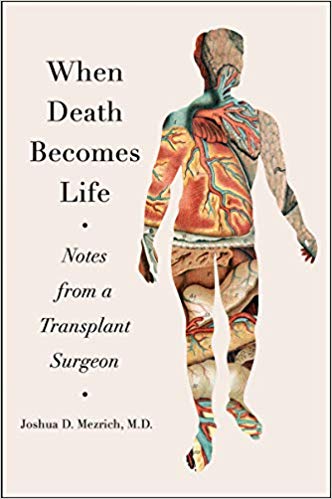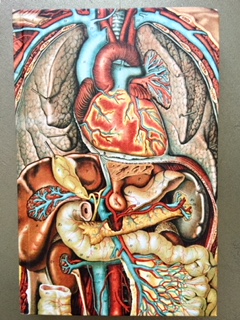
“When Death Becomes Life” by Joshua D. Mezrich focuses on three compelling aspects of the century-old practice of human organ transplantation: its history, the author’s experiences as a surgeon, and ethical questions the operations raise. Through each lens, the procedure never loses its sense of wonder.
At first, some of the details of organ transplant operations seem both technical and, well, a bit gory, as incisions are described, arteries are snipped, and organs are either procured from a donor or transplanted into a human patient. There’s a fair amount of talk about blood, urine and bile, depending on the organ. But the reader gets used to body parts and functions the way one adapts to reading subtitles through a foreign movie. What starts off as challenging becomes effortless as a gripping story moves along. And a successful transplant never seems anything less than miraculous when a donor organ suddenly starts to beat or turn pink or fill with urine once attached to the patient.
 Over 100 Years of Organ Transplants
Over 100 Years of Organ Transplants
Early in the book, Dr. Mezrich, a kidney and liver transplant surgeon on staff at the University of Wisconsin Hospital since 2007, introduces historic strides in transplantation. He avoids sounding like a textbook by also weaving in a narrative about his early involvement in procuring and transporting organs to waiting patients.
A few of the strides are the first instance of tying two blood vessels together (essential for attaching organs on operating tables) in late 19th century France; the introduction of dialysis during WWII; and Dr. Christian Barnard performing the world’s first human-to-human heart transplant in South Africa in 1967. The author explains that Dr. Barnard — who was trained at the University of Minnesota — got a jump on the competition because, at the time, South Africa recognized death as the moment when two doctors declared a patient dead. This made procurement of the donor heart easier than in the United States where “brain dead” had not yet been legally defined. Just over 60 years later, organ transplants in the United States set its sixth consecutive record – with 36,527 performed.
Doctors and Patients as Human Beings

The hardcover version of Joshua Mezrich’s book
As medically intensive as the memoir reads, Dr. Mezrich does not lose sight of the humanity of the people involved in a transplant scenario. First, there are the organ donors the title of the book refers to — whose deaths set into motion life-saving surgeries for very sick people. He goes on to say that meeting the deceased’s grief-stricken families “continues to be one of the most difficult and, at the same time, most rewarding aspects” of his job. “These people are going through the worst experience of their lives, as most donors die far too young and unexpectedly.” The donors’ ultimate gift of life (which can go to as many as seven waiting strangers) becomes “the one positive notion that family members can hold on to.”
As much as the surgeons in “When Death Becomes Life” appear to be miracle workers, the author unmasks their humanity, applying the reality check to himself as well. Though the vast majority of Dr. Mezrich’s surgeries are successes, he addresses the stress and decisions he had to make at the operating table that became matters of life or death. He admits killing an elderly woman during his residency days, apparently by puncturing her lung while trying to place a central line near her heart. He recalls another medical error later in his career, when he realized, the day after performing a liver transplant, that he had forgotten to tie a duct shut. He was able to take the man back to the OR and close it, and the man is doing well today.
Questions With No Easy Answers
Ultimately, the doctor invites his reading audience to ponder questions about organ transplantation that he feels need to be addressed in the future. When the transplant involves a live donor, he asks how much risk should a healthy person be allowed to take to save someone they love? When he brings up whether or not alcoholics should receive healthy livers, he implies that our health care system needs to better address the causes and treatment of addiction as well as replace diseased livers.
“When Death Becomes Life” by Joshua D. Mezrich both educates and fascinates. While it examines some of the greatest medical advancements of all time, it touches the heart and soul of the gift of life as well.

 “When Death Becomes Life” by Joshua D. Mezrich, M.D.
“When Death Becomes Life” by Joshua D. Mezrich, M.D.


 Having an Estate Plan Is Essential – So Is Discussing It With Your Children
Having an Estate Plan Is Essential – So Is Discussing It With Your Children
 The Healing Sound of Singing Bowls
The Healing Sound of Singing Bowls
 “Summons” by Aurora Levins Morales
“Summons” by Aurora Levins Morales














